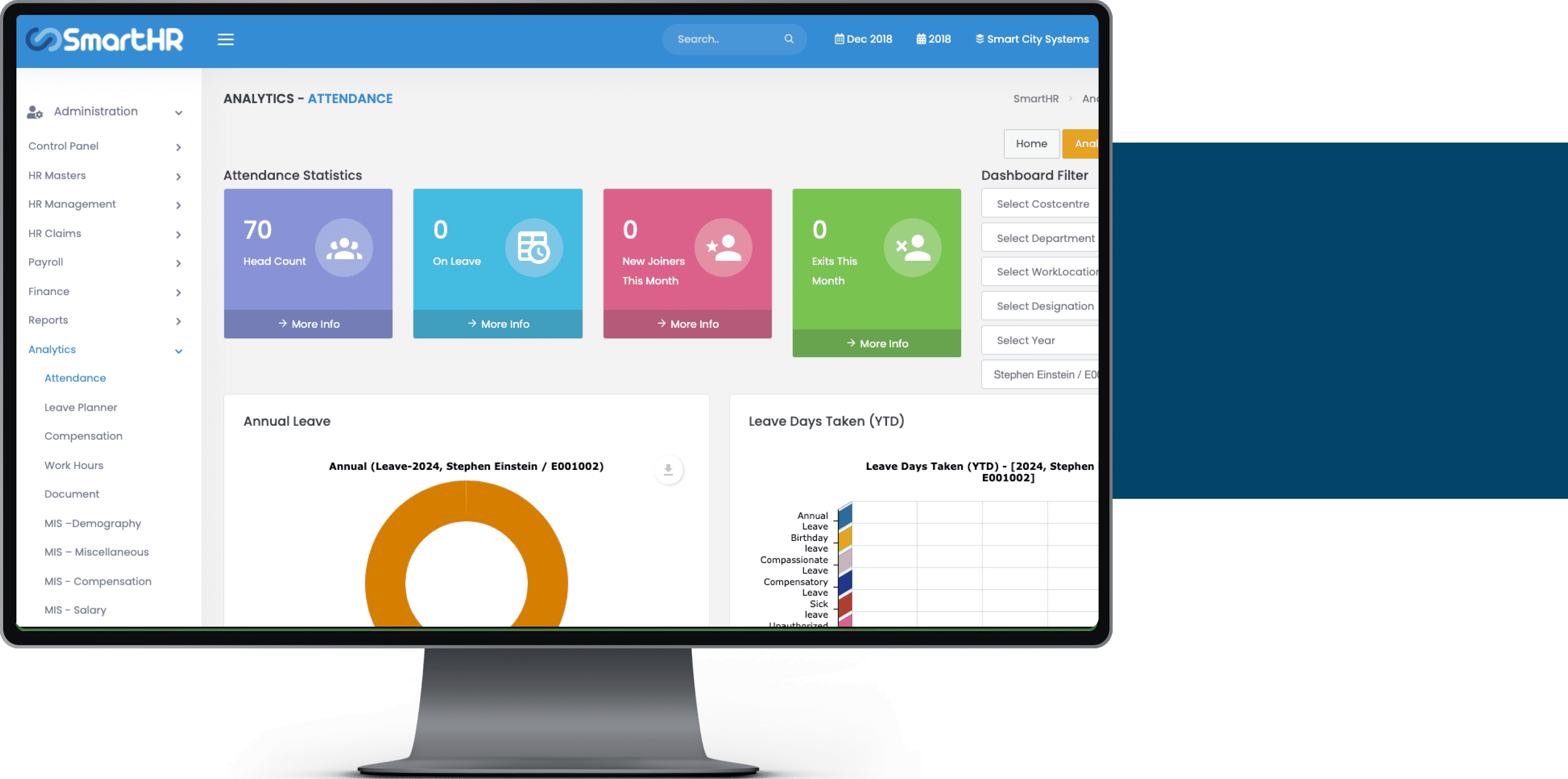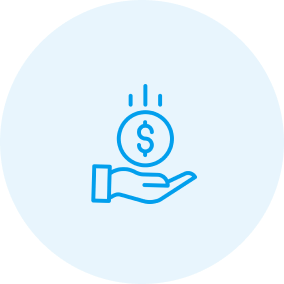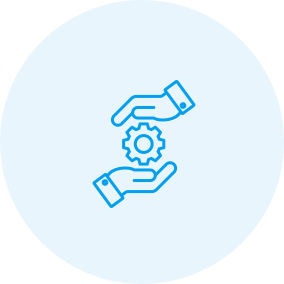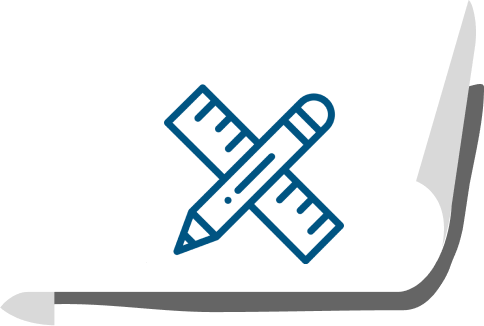Empower Your Workforce with Cloud-Based HR Software Dubai
Tailored HR Solutions for Gulf Businesses: SmartHR Cloud Dedicated Instances
Smart City Systems offers you the best SmartHR Cloud Dedicated Instances HR Software in Dubai, Abu Dhabi & other Gulf regions. Our platform provides tailored SaaS applications designed to meet your organization’s unique needs. With autonomous data storage, our software fosters specialization and independence, ensuring unparalleled HR management.
For companies looking for specialized HR management solutions, SmartHR Cloud Dedicated Instances HR Software provides a complete solution. Our platform provides customized SaaS applications, ensuring that each organization’s unique needs are met. With autonomous data storage, users can enjoy specialized functionalities while maintaining independence. The HR software SmartHR Cloud Dedicated Instances sets the way for unmatched HR management by enabling companies to maximize productivity and simplify their operations.

What is Cloud Based SaaS HR Software?
Cloud-based Software as a Service (SaaS) HR software refers to a type of human resources management system that is hosted in the cloud and delivered to users over the internet. This means that instead of installing the software on their own computers or servers, users access it remotely through a web browser.
Cloud-based SaaS HR software offers several advantages over traditional on-premise HR software, including:

Accessibility
Users can access the software from anywhere with an internet connection, making it ideal for remote or distributed teams.

Cost-effectiveness
Because there is no need for on-premise hardware or infrastructure, cloud-based SaaS HR software is often more cost-effective for businesses.

Scalability
Cloud-based SaaS HR software can easily scale up or down based on the needs of the organization, making it suitable for businesses of all sizes.

Automatic updates
Users always have access to the newest features and security upgrades because of the software provider's handling of updates and maintenance.
Unlocking Efficiency: Benefits of Cloud SaaS HR Software
HR budgeting is essential for strategic resource allocation efficiently, control costs, and make informed decisions about your workforce. It facilitates informed decision-making, aligning HR initiatives with organizational goals. By investing in your employees’ development and well-being, you can create a positive work culture that attracts and retains top talent. HR budgeting is important for several reasons:
One of the key benefits of cloud SaaS HR software is its cost-effectiveness. Because the software is hosted on the cloud, businesses do not need to invest in expensive hardware or software licenses. Instead, they pay a monthly or annual subscription fee, which is typically based on the number of users or the level of service required. This makes cloud SaaS HR software a cost-effective solution for businesses of all sizes.
Cloud SaaS HR software is also highly scalable and flexible, making it ideal for growing businesses. Because the software is hosted on the cloud, businesses can easily add or remove users as needed, without the need for additional hardware or software. This makes it easy for businesses to scale their HR processes as their workforce grows, without the need for a major investment in new technology.
Optimizing HR Management: Benefits of Cloud-Based SaaS HR Software
Many aspects of cloud-based software as a service (SaaS) HR are intended to optimize corporate effectiveness and streamline HR procedures.

Employee Self-Service (ESS)
ESS allows employees to access and manage their personal information, such as updating contact details, submitting time-off requests, and viewing pay stubs. This reduces the administrative burden on HR staff and empowers employees to take control of their HR-related tasks.

Recruitment and Onboarding
This feature helps streamline the recruitment process by posting job openings, tracking applicants, and managing the onboarding process for new hires. It can include features such as resume parsing, background checks, and electronic document signing.

Training and Development
This feature helps organizations manage employee training and development programs. It can include tools for course registration, tracking certifications, and assessing skills gaps, ensuring that employees have the necessary skills for their roles.

Seamless System Integration
Cloud SaaS HR software can integrate with other systems, such as accounting or ERP software, to streamline data flow and ensure consistency across the organization. By integrating, manual data entry errors are decreased and efficiency is increased.

Payroll Management
Cloud SaaS HR software automates the payroll process, calculating wages, deductions, and taxes. It also facilitates direct deposits and generates payroll reports, ensuring accurate and timely payments to employees.

Performance Management
Organizations may create goals, monitor progress, and evaluate employee performance with the use of cloud-based SaaS HR software. It provides tools for feedback, coaching, and performance improvement, helping to enhance employee performance and engagement.

Compliance and Reporting
By automating compliance tracking and reporting, cloud-based SaaS HR software assists businesses in compliance to labor laws and regulations. It generates reports on employee demographics, turnover rates, and other key metrics, helping organizations make informed decisions.

Mobile Accessibility
Employees and managers may access HR data and complete activities while on the go with the help of numerous cloud-based SaaS HR software solutions that offer mobile apps or responsive web interfaces. This improves accessibility and flexibility for employees working remotely or in the field.
Seamless Deployment and Integration: Implementing Cloud SaaS HR Software
A number of crucial actions must be taken while implementing cloud-based SaaS HR software to guarantee seamless implementation and system integration. Here’s a detailed overview of the process:

Assessment and Planning
The first step is to assess your organization's HR needs and existing systems. Identify the key requirements and objectives you want to achieve with the new software. Develop a detailed implementation plan, including timelines, resource allocation, and budget.

Data Migration
Migrating data from your existing HR systems to the cloud SaaS HR software is a critical step. Ensure that data is transferred accurately and securely, taking into account data mapping, formatting, and validation.

Configuration and Customization
Configure the cloud SaaS HR software to align with your organization's specific requirements. Customize the software to accommodate unique processes and workflows, such as approval processes, leave policies, and organizational structures.

User Training
Provide comprehensive training to HR staff, managers, and employees on how to use the new software effectively. This includes training on basic functionalities, such as entering time-off requests and accessing pay stubs, as well as more advanced features, such as performance management and reporting.

Integration with Other Systems
Integrate the cloud SaaS HR software with other systems used within your organization, such as accounting, payroll, and ERP systems. Ensure that data flows smoothly between systems, avoiding duplicate data entry and ensuring data consistency.

Testing and Quality Assurance
Conduct thorough testing of the cloud SaaS HR software to identify and resolve any issues or bugs. Test the software's functionality, usability, and performance to ensure it meets your organization's requirements.
Securing Data Integrity: Security and Compliance in Cloud SaaS HR Software
Security and compliance are paramount considerations when implementing cloud SaaS HR software. Here’s how these aspects are addressed:

Data Encryption
Cloud SaaS HR software uses encryption to secure data both in transit and at rest. This ensures that sensitive information, such as employee personal details and payroll information, is protected from unauthorized access.

Access Controls
Role-based access controls (RBAC) are implemented to restrict access to sensitive HR data. Only authorized personnel have access to certain information, reducing the risk of data breaches.

Regular Security Updates
Cloud SaaS HR software providers regularly update their software to patch vulnerabilities and protect against emerging threats. This ensures that the software is up to date with the latest security protocols.

Compliance with Regulations
Cloud SaaS HR software complies with data protection regulations such as GDPR, ensuring that employee data is handled in accordance with legal requirements. This includes obtaining consent for data processing and providing mechanisms for data subjects to access, correct, or delete their data.

Data Backup and Recovery
Cloud SaaS HR software providers implement robust backup and recovery processes to ensure that data is protected against loss or corruption. This includes regular backups and the ability to restore data quickly in the event of a disaster.

Auditing and Monitoring
Cloud SaaS HR software includes auditing and monitoring features that track user activity and access to sensitive data. It helps in the real-time identification and mitigation of security vulnerabilities.

Elevate Your HR Management with SmartHR Cloud Dedicated Instances HR Software: Experience the Difference Today!
Elevate Your HR Management with SmartHR Cloud Dedicated Instances HR Software: Experience the Difference Today!
Frequently asked Questions
Certainly, cloud-based HR software as a service (SaaS) may be tailored to each company’s particular needs and objectives.
